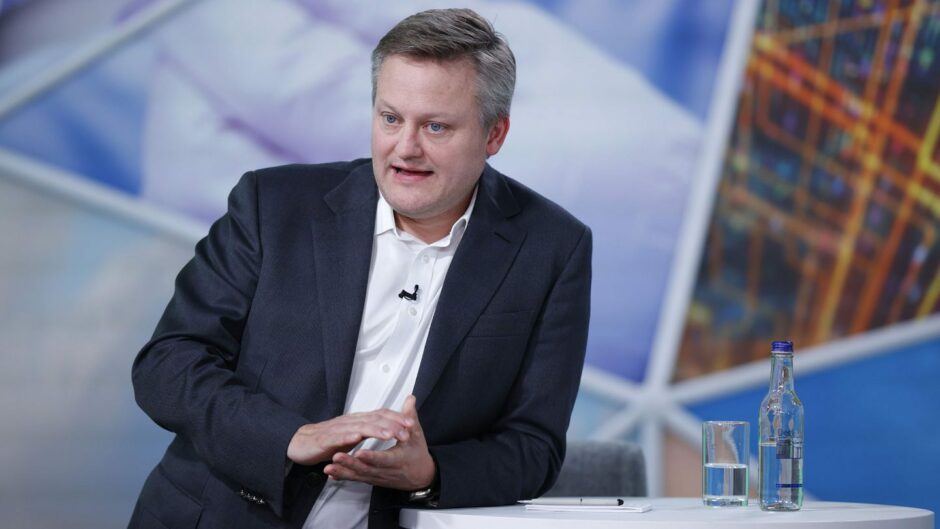
BP plans to carve out its offshore wind assets as part of a joint venture with Japan’s largest power generation company, as oil supermajors move to insulate themselves from share price shocks associated with their low-carbon investments.
“This will be a very strong vehicle to grow into an electrifying world, while maintaining a capital light model for our shareholders,” BP chief executive Murray Auchincloss said in a statement.
Far from stepping back from its low-carbon strategy, the offshore wind partnership will provide the London-listed oil giant with “green electrons” that could help decarbonise areas of the business, such as BP’s electric-charging business BP Pulse and its refineries across Europe.
“We’ve been clear we want to grow in renewables,” a BP spokesman told Energy Voice, adding that the company wants to keep investments in low carbon “capital light” for shareholders.
The new offshore wind business with Jera, called JERA Nex bp, is expected to be one of the biggest five offshore wind developers in the world by capacity.
The combined offshore wind capacity of the two developers is 13 GW, including a mix of operating assets, projects in development and site leases. That includes operating assets of 1 GW and a 7.5 GW pipeline of developmental stage projects, together with leases secured for a further 4.5 GW of potential capacity.
Auchincloss, who stepped up from chief financial officer after Bernard Looney’s departure in 2024, has been accused of stepping back from the low-carbon strategy implemented by his predecessor.
“At least, European majors, like BP, Equinor, Shell and so on, they all had… this to a varying degree, focus on the energy transition,” said Rystad Energy vice president of renewables and power research Fabian Ronningen.
“But I think what we have seen the last few years is that some of these ambitions have been scaled back a little bit.”
The latest tie-up with Jera, Japan’s largest power generator, builds on an existing partnership between the companies: “BP and JERA, and its shareholders Tokyo Electric Power Company (TEPCO) and Chubu Electric Power, have a very long history of partnership, both historically in LNG and more recently in pursuing possibilities for cooperation in solar, hydrogen and low carbon fuels.”
‘Capital light’
BP’s spokesman said the new joint venture will help grow its offshore wind operations in a way that is right for both BP and its shareholders, adding: “We still see real value in renewables.”
The reorganisation and carving out of its offshore wind business will “reduce BP’s anticipated capital investment into renewables through the rest of this decade”.
“The move means the wind projects will not have to compete for investment capital within BP,” a spokeswoman added.
Another incentive for BP is that it can explore finance “off its balance sheet”, the spokesman said.
The tie-up is expected to take nine months to set up and could be operational by the third quarter of next year, he added, indicating that BP’s capital commitment is “significantly less” than what the market had forecast.
The BP spokesman indicated that appetite for electrification exists within the business, and that BP remains committed to investing in low-carbon assets cost-effectively and with trusted partners: “The key is returns and value.”
BP and Jera have agreed to make defined investments into the joint venture through the end of the decade, with a defined contribution of up to a combined $5.8bn.
The spokesman said BP would deploy a maximum commitment of $3.25 billion into the offshore wind joint venture, compared to $2.55bn deployed by Jera.
This asymmetric investment commitment takes into account the fact that BP is not bringing any operating assets to the table, the spokesman added.
As a pureplay offshore wind developer, it could also be easier for the joint venture company to secure finance for offshore wind with a pureplay business, given the widespread retrenchment of banks from oil and gas.
The spokesman denied that the oil company is looking to float the joint venture on the stock market, which could provide a partial exit.
BP is expected to nominate a chief financial officer for the new entity, while Jera will put forward a candidate for chief executive.
Portfolio
BP said the tie-up will accelerate the development of projects in its portfolio, including those that are already at an advanced stage in Europe, Japan and Australia.
“Initially it is expected to focus on progressing existing projects in Northwest Europe, Australia and Japan, and to continue to mature the development pipeline of significant longer-term opportunities,” the company said.
While BP has no operating offshore wind turbines anywhere in the world, it does have a pipeline of development-stage offshore wind projects.
The joint venture is not expected to be cash generative for the first five or six years. While certain assets brought by Jera are already cash generative, proceeds will be reinvested and redeployed within the business, according to the spokesman.
“We will retain access to our equity share of power offtake and will continue to enable value for our trading business,” the BP spokesperson said.
William Lin, BP executive vice president for gas and low carbon, said the new company will invest “with tight discipline” and secure “optimal offtake arrangements”.
Projects in the combined portfolio include the Gunfleet Sands project in the UK, and the Oriel development-stage project in Ireland.
BP has been building an offshore wind portfolio since 2019 and has a development pipeline with net 9.7 GW of potential capacity, including the Morgan and Mona projects in the Irish Sea and leases secured off the Scottish coast.
“We very much look forward to combining our strengths in Europe and Asia-Pacific,” said Auchincloss.
– Additional reporting by Erikka Askeland
Recommended for you


 © Supplied by Access2Funding
© Supplied by Access2Funding © Samyukta Lakshmi/Bloomberg
© Samyukta Lakshmi/Bloomberg